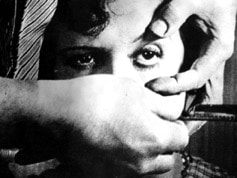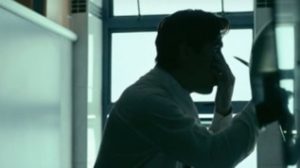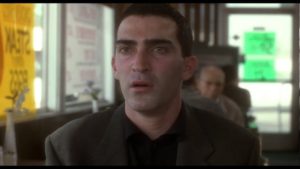How to Write a Surrealist Film: The Core Principles of Surrealism
Surrealist film tends to fall far from the aims of the original Surrealist movement. This article will demonstrate how to write a film that is authentically surreal.
How can you represent surrealism in screenwriting? And what does great surrealism look like in cinema? We’re going to take a look.
But first…
What is Surrealism?
Breton and Beginnings
The father of surrealism and author of the Surrealist Manifesto, André Breton, once argued that film viewers enter a state between being ‘awake and falling asleep’.
Think of the cinema. Spectators, sat in the dark, watch images flash before their eyes. The experience is often compared to dreaming.
And yet, Breton, inspired by Sigmund Freud’s psychoanalysis, didn’t see dreams as a distraction. Instead, they offered windows to a hidden subconscious and so allowed new ways of exploring our reality.
- Breton, and the other surrealists, wanted to re-order reality in order to bring about political change.
Much of contemporary cinema—indeed much of contemporary media—could be seen as visually ‘surreal’. Events that occur in everything from a mouthwash advert to a Marvel movie are surreal in the sense that they distort rather than mimic reality.
However, not many filmmakers are aware of the original objectives of the surrealist movement. Breton would likely be appalled that today surrealist tropes are used to reinforce, rather than to undermine, the current economic system.
The Dream Factory
One Listerine advert depicts a man swirling mouthwash. He subsequently spits it out. This prompts a huge blue wave to wash across a beach.
- Here, surrealist imagery is used to market a product. So, the advert sells us a dream.
- Similarly, big budget Hollywood cinema is often nicknamed the ‘Dream Factory’.
- However, both these allusions to dreaming—both passive forms of consumption—fall devastatingly far from surrealist ideology.
When Breton compared cinema to dreaming, he did not mean a daydream of another world. Instead, he tried to conjure a way of interrogating our own world.
In this article, we will focus on David Lynch‘s and Yorgos Lanthimos‘ films. Both filmmakers are still working today. They are rare because they use surrealism to challenge, rather than reinforce, the restrictions of society.
In short; this article will use the two filmmakers to show how to write a truly surrealist film. So what are the core elements and principles that make up a surrealist film?
Mark Kermode reviews Buñuel and Dalí’s Surrealist masterpiece Un Chien Andalou (1928) | BFI Player
1) Surrealist Film: A New Way of Seeing
Salvador Dalí, the famous surrealist artist, and Luis Buñuel, the similarly renown filmmaker, made one of the first surreal movies.
- Un Chien Andalou, made in 1929, is a patchwork of bizarre scenes that pulse with a priapic undercurrent.
The most well-known shot in the film is this one:

Even in the era of CGI, few images are as horrifying as this extreme close-up of an eye sliced open with a razor blade. Dalí and Buñuel’s point was simple. In short, their surrealist movement was to boldly usher in a new way of seeing.
The image comes near the start of the film and so at least one critic has argued that it acts as a kind of warning. The subsequent action would speak not to our actual vision but to man’s subconscious.
Now look at this image from the end of Yorgos Lanthimos’ The Lobster:

Again, a blade hovers in front of an eye. Like his surrealist predecessors, Lanthimos uses the image to indicate a new kind of seeing. So here is another director who speaks to the subconscious.
She Wore Blue

And now watch this scene from the opening of David Lynch’s Blue Velvet:
A hyperbolically happy middle-class neighbourhood.
- A beaming lollipop lady waves children across the street.
- Firemen wave on their way to save the world.
- Big houses. Immaculately mown lawns. Red rose and white picket fences.
But then there’s a problem.
- A kink in the garden hose. The man collapses. All is not quite as it seems in this suburbia.
- And then the camera descends beneath the grass.
- Ominously, we sink below the skin of the contented neighbourhood into a menacing darkness.
- Here we eventually see a severed ear.
In short, this scene perfectly encapsulates surrealist cinema’s aim.
- It descends below the surface of human society to search for that which lingers underneath.
- It looks to explore our dark, hidden subconscious.
2) The Nightmare in Surrealist Film
Surrealist film often gives bodies to our deepest anxieties. Specific characters and scenes often take on a kind of nightmarish, half-real quality.
So, when writing a surrealist film, horrifying characters or scenarios can prove an effective way of depicting the subconscious. Lanthimos and Lynch provide abundant examples.
First, let’s focus on David Lynch’s diner scene in Mulholland Drive. It is one of the most infamously nightmarish scenes in modern cinema.

- Note the contrast, as in the Blue Velvet opening, of everyday environment (typical diner) with horrifying undercurrent.
- Something horrible lingers behind the bins, hidden in the parking lot.
- We don’t want to see this creature, and yet we inevitably encounter it.
We all have similar nightmares. And yet, although this scene is a vivid depiction of a nightmare, it also something more.
- This is not just a bad dream. Lynch finds a real darkness lingering beneath the world of cheap coffee and egg and bacon.
- Each viewer will likely project their own anxieties onto this scene. We all have domineering fears that pervade our real lives.
Throughout Mulholland Drive Lynch suggests the ‘real’ world and the ‘dream’ world are much closer together than we often presume. Our dreams, our fears, and even our nightmares, bleed into our realities and dictate how we live our lives.
3) The Uncanny in Surrealist Film
Often surrealist filmmakers will utilise the ‘uncanny’. Freud defined the uncanny as:
‘That class of the terrifying which leads back to something long known to us, once very familiar’.
For Freud, things that look familiar but aren’t are particularly terrifying. He uses the example of a dummy or a waxwork doll. According to Freud, dummies are frightening because although they look human, they aren’t.
Think of the creature behind the dumpster in Mulholland Drive. It distantly resembles a human. It’s recognisable and yet simultaneously alien.
Blood and horror are now ubiquitous in contemporary cinema. And yet surrealist filmmakers are aware of the ability of the uncanny to shock above violence and gore.
- It is no coincidence that the sliced eye in Un Chien Andalou maintains such potency.
- Or that the Dumpster man is still so frightening.
- Both images are not just horrifying—they are uncanny. They are the familiar made horrifying.
For Breton, surrealism was intended to shock by rearranging the already known. So, traditional images were distorted or parodied.
- We might immediately think of the most famous surrealist symbol—Dalí lobster’s propped on a telephone.
- The everyday became unusual in order to startle viewers and make them reassess the world around them.

In writing a surrealist film, it is a good idea to incorporate uncanny elements. They have a real power to shock and provoke. And they might challenge audiences who are numb to explosions, blood, and gore.
Nothing is Quite Normal
Lynch and Lanthimos make entirely uncanny movies. The truly bizarre, and often horrifying, punctuates the everyday.
Lanthimos’ The Killing of a Sacred Deer is a brilliant example of an uncanny film. Every scene in this movie imitates but then subverts audience expectation.
- The film is about an accomplished cardiovascular surgeon, Steven Murphy and his strange friendship with a teenage boy, Martin.
- The relationship between the two is immediately unsettling. We wonder why they hang out. Are they just friends? Is there a predatory aspect to this relationship? Why is a high-level doctor hanging out with this child?
- The cardiovascular surgeon lives the perfect middle-class life. He lives in a luxurious home with his two children and wife. But then one child begins to fall ill. Then the other.
- Martin delivers Murphy a grim ultimatum; ‘kill one of your children or your wife or all three will die’.
Over the course of the film, Martin’s presence grows increasingly menacing. From the start, we are never quite sure where to place this character. And he only becomes creepier as the plot develops.
Evading Meaning
Watch the following scene:
On first viewing, it’s likely that you’ll find the scene unsettling, but not be entirely sure as to why. Here are some suggestions:
First: Power balance.
- Even though Murphy is much older, Martin seems to be in control of the conversation. It is Martin who demands Murphy reveals his chest. And it is Martin who presses an invite onto Murphy.
- The level of control Martin has over Murphy feels unusual.
Second: Dialogue.
- Martin and Murphy’s conversation is a curious mixture of the bizarre with the mundane.
- Lanthimos’ characters often speak like uncanny human replicas. Lanthimos suggests there is something unhuman about contemporary human existence.
Third: Hairy chests.
Discussing hairy chests at all is, of course, incredibly unusual. Importantly, the discussion on hairy chests seems to represent something beyond itself, and yet it’s difficult to know what. Suggestions for what the hairy chests could mean:
- A forced familial relationship between the two. This conversation is the kind a child might have with his father. And yet, taken out of context, and between a man and a teenager who are unrelated, the attempt to create a paternal bond feels manufactured.
- There is a sinister, unfulfilled sexuality that bubbles under the film. This scene, while decidedly unerotic, does seem to teeter towards sexual contact when Murphy starts to undress.
- Chest hair is a traditional symbol of masculinity. Martin weighs himself up against Murphy.
However, perhaps the point is that there is no clear parallel for the hairy chest. It does not clearly represent anything. It’s a symbol that signifies nothing in particular.
Lanthimos subverts the audience’s expectations of understanding. We are left mulling over the ideas and images obsessively, in a desperate and futile search for meaning.
The Killing of a Sacred Deer | Official Trailer HD | A24
4) Satire in Surrealist Film
Crucially, when Breton refined surrealism in his second manifesto of 1930, he emphasised the need for application of the movement.
Most importantly, he wrote ‘everything remains to be done, every means must be worth trying, in order to lay waste to the ideas of family, country, religion’.
- Breton continually stressed the importance of the movement’s political potential.
- That is to say, surrealism was not only about the depiction of the subconscious.
- Rather, this depiction of the subconscious was a tool to attack and critique society.
- And the hope was that this kind of critique would bring about real change.
Both Lanthimos and Lynch use surrealism with a satirical edge.
This Dream Place

Mulholland Drive can be interpreted as a critique of Hollywood and the movie business. Lynch suggests that Hollywood is damaging both to the filmmaker as an artist and to individuals who fall for its constructed illusions.
- In the film, two obscure men force a movie director, Adam Kesher, into picking a particular woman as the lead for his next movie.
- The suited pair are a mysterious force that appears in opposition to the artistic goals of the director.
- Clearly, Lynch lambasts the role of studios and big business that limit a filmmaker’s creative freedom.
A more developed critique of Hollywood, however, is shown in Betty’s (the film’s protagonist) narrative.
- In the first half of the film, Betty, an aspiring actress, falls in love with Rita.
- Rita is a beautiful amnesiac, who epitomises the Hollywood femme fatale stock-character. She is always perfectly made-up, or glimpsed in a mirror, and so her very presence is dream-like.
- Betty takes a number of successful auditions where directors affirm her talent.
- In the second half of the film, however, Betty wakes up.
- The entire first half—her imagined life as a successful actress—was an illusion.
- At the end of the film, unable to reconcile her miserable reality with her fantastic aspirations, Betty kills herself.
Hollywood, a dream factory, manufactures fantasies on screen. However, Lynch suggests that the fantasies nurtured in viewers off screen reveal a darker side to Hollywood.
- The filmmaker argues that the way in which woman are presented in mainstream cinema fosters unrealistic expectations. A desire or expectation is created that can never be fulfilled.
Lynch uses surrealism to launch satirical hand grenades at Hollywood. For this director, big budget cinema has blurred the boundaries between what is real and what is not, with horrifying, deeply damaging, consequences.
Lobsters and Love
Lanthimos’ surreal elements are similarly clawed.
In The Lobster single human beings, imprisoned at a luxury hotel, have forty-five days to find a suitable partner. If they fail, they transform into an animal of their choosing.
As with The Killing of a Sacred Deer, this film (deliberately) resists interpretation. And yet, a possible way to view The Lobster is as a sustained satire on contemporary relationship norms.
Firstly, the modern societal taboo on singleness is parodied in the mandatory requirement that all humans are coupled .
Second – bisexuality is banned in the hotel.
- The protagonist is downcast when he is told to choose between genders.
- The hotel seems to implement the policy for no apparent reason.
- Lanthimos comments here on the absurdity of taboos against any sexual orientation.
Third—the single individuals in the hotel bond over the most fatuous, superficial similarities.
- For example—couples feel they are the ‘right’ for each other because they both like tennis or are both are prone are to nose bleeds.
- Perhaps here Lanthimos is laughing at modern dating apps where couples bond because they share a taste in pop music or both like dogs.
- Love has been reduced to an exchange of shared, material interests in our commodified society.
And Finally – A Truly Surrealist Scene
To conclude, let’s analyse this clip from David Lynch’s Eraserhead:
This scene neatly (or rather— grotesquely) includes all the elements analysed in this article. That is to say, the clip is a great example of how to write a truly surrealist scene in a film.
A New Way of Seeing
Eraserhead was David Lynch’s first film. The movie ushered in a new way of seeing. Lynch’s surrealism revolutionised cinema. He has been labelled the ‘first popular Surrealist’ filmmaker.
Eraserhead, like all of Lynch’s best work, burrows into the viewers subconscious. Like Dalí and Buñuel all those years before, Lynch foregoes conventional narrative and writes dreamy, bizarre screenplays.
Perhaps the most Lynchian symbol in this clip comes at 4.27.
- The light bulb that flickers.
- An electrical energy pulsates beneath the surface. There is light and then darkness.
- So Lynch illuminates the previously unseen. Something hidden emerges.
A Nightmare
It’s tempting to interpret not only this scene, but the whole film, as a nightmare. The atmosphere is dreamlike. The room is dark in this scene. No-one says anything normal.
However, as with Breton, the nightmare does indicate hidden anxieties.
- Some people find this scene impossibly complex and alien.
- Others see it as a fairly accurate representation of the anxieties of meeting a girlfriend/boyfriend’s parents for the first time. The impossible awkwardness, the forced smiles, and the desperate attempts at conversation with no success.
Above all, Lynch, as so often in his work, embodies human anxieties.
- This scene isn’t a ‘realistic’ depiction of a boyfriend meeting his girlfriend’s parents.
- And yet, it’s a poignant portrayal of youthful anxiety.
- There is something real in the scene’s surrealness.
The Uncanny
No-one forgets the sight of a miniature chicken secreting foul brown liquid. We share the protagonist’s horror.
And this image is much more powerful and memorable than much of what we see on screen today. The reason for this is because it’s so uncanny.
- The everyday is made horribly unrecognisable.
- Not only is the chicken an usual size, but it subsequently explodes and starts to leak thick brown liquid.
- A conventional family dinner is punctuated with the absurd.
- Even the mother’s reaction, her sudden hysteria, is uncanny.
Lynch, as ever, leaves interpretation to the viewer. But one way of reading this, given the quite violent ejaculation of liquid, is as a kind of sexual anxiety.
As previously mentioned, Breton, and the original surrealists, were fond of Freud. Their work tends to pulse with sexual references. Lynch, and particularly Eraserhead, follows their lead.
Satire
Once more in line with Breton, Lynch’s absurd scene is ripe for a satirical reading.
- At 4.44, the mother, interrogating the protagonist, declares ‘did you and Mary have sexual intercourse?’
- Subsequently, she starts trying to kiss and seduce the protagonist.
The film was made in the late 70s. So sexual attitudes, particularly among older generations, were less liberal than they are today.
Lynch highlights the absurdity of societal sexual repression by having the mother both lambast and encourage sexuality. The hypocritical mother is unable to keep to her own rules.
So, perhaps the filmmaker’s implication is that restrictions on sexuality are damaging and repressive for everyone—including those who enforce such restrictions.
Comic
Finally, there is much dark comedy in this scene. Above all, it’s hard not to giggle at the sheer absurdity.
Surrealism, from Breton onwards, has always been a movement that has emphasised the use of comedy. Think of the lobster on the telephone. Often things that are ‘uncanny’ teeter between amusement and fear.
Moreover, Lanthimos and Lynch both create hilarious movies.
‘Surreal’ is an increasingly common word in contemporary language. Bumping into someone we know at the airport is ‘surreal’. Being inside for the coronavirus lockdown is ‘surreal’.
It is important, however, when writing a surrealist film, to remember the aims of the original surrealist movement.
- Surrealism aimed at exploring the bizarre and the strange with the intention of implementing real societal change.
Write like Lynch and Lanthimos. Write surrealism with pincers. Don’t use surrealism as a stylistic choice. Use it to say something meaningful and powerful about the human condition.
– What did you think of this article? Share It, Like It, give it a rating, and let us know your thoughts in the comments box further down…
– Struggling with a script or book? Story analysis is what we do, all day, every day… check out our range of script coverage services for writers & filmmakers.
format-boundary=”true”>This article was written by Charles Macpherson and edited by IS Staff.
Get *ALL* our FREE Resources
Tackle the trickiest areas of screenwriting with our exclusive eBooks. Get all our FREE resources when you join 60,000 filmmakers on our mailing list!


Absolutely loved this analysis of surrealist cinema. A breath of fresh air to me, particularly, since I personally have a penchant and love for that specific form of narrative. Definitely look forward to further reads from this site.
So glad you enjoyed it James!